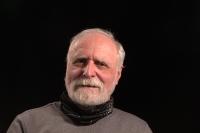They were shooting in all directions. Inches away and I could have died.
Download image
Jan Mohr was born on December 26, 1950 in Liberec. His parents were totally deployed during World War II. After the war, they both moved to Liberec, where they met and later got married. Jan Mohr studied artistic blacksmithing and locksmithing at the secondary school of arts and crafts in Turnov. At the age of eighteen, he witnessed the invasion of the Warsaw Pact troops into Czechoslovakia. During normalization, he studied art history and history in Brno. However, due to the low number of accepted students, he had to enter the zero year and worked as a construction worker. In 1975, he returned to his native Liberec, first working at the Regional Gallery, later applying for the position of art historian at the North Bohemian Museum. Here, during his work, he came across the boundaries of the then regime several times. During the Velvet Revolution, he and the museum team participated in demonstrations in Liberec and experienced the immediate withdrawal of the museum director. Even after the regime change, he continued to work as an art historian at the North Bohemian Museum. In 2022, Jan Mohr still lived in Liberec.
